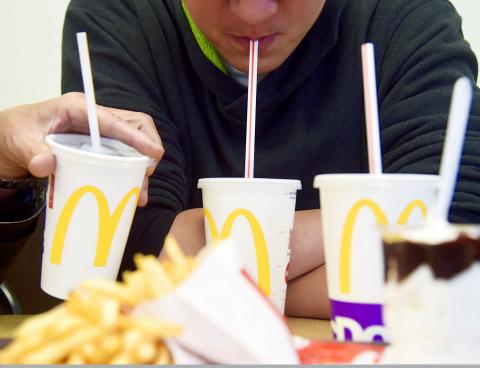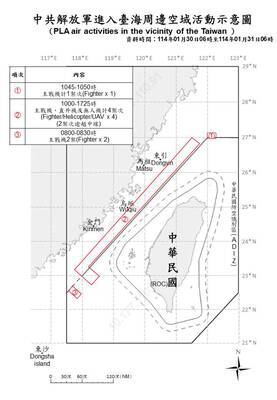The Environmental Protection Administration (EPA) yesterday introduced a series of plans to reduce the use of plastic products that cause marine pollution, with the use of plastic straws expected to be limited next year and disposable tableware banned by 2030.
The plans were jointly drafted by the agency and eight environmental groups, which formed a coalition on marine waste disposal in July last year.
“Marine pollution has become another serious environmental problem for the world, in addition to global warming,” said Tse-xin Organic Agriculture Foundation member Chen Li-hsin (陳立信), who discussed their collaboration over the past six months at a news conference in Taipei.

Photo: Huang Yao-cheng, Taipei Times
The coalition has launched 67 action plans that focus on four areas: source reduction; prevention and removal of marine waste; research and investigation; and expanding public participation, he said.
In particular, the plans target plastic bags, disposable tableware, plastic straws and beverage cups, many of which end up as garbage on beaches, Chen said, adding that the coalition hopes to gradually ban the use of those products in 12 years.
With 2020 as the first signpost, the EPA would require restaurants to stop providing plastic straws, while extending its ban on plastic shopping bags to all stores that give invoices for consumption, it said.
By 2025, the bans on plastic bags, disposable tableware, take-out beverage cups and plastic straws are to be extended to more businesses, the agency said, adding that it would increase their prices to restrict their use.
By 2030, it would ban the use of all plastic shopping bags, tableware, take-out beverage cups and straws.
These plans aim to create a sustainable environment for future generations, EPA Minister Lee Ying-yuan (李應元) said.
Most businesses have been willing to cooperate with the expanded ban on plastic bags that took effect last month, he said.
The EPA will also conduct more beach cleanup activities and ask local environmental bureaus in municipalities near the sea to monitor beaches every season to investigate the sources of garbage, Department of Water Quality Protection Director-General Yeh Chun-hung (葉俊宏) said.
The other members of the coalition are the Wild at Heart Legal Defense Association, the Taiwan Environmental Information Association, Hiin Studio, the Society of Wilderness, the Sea Citizens Foundation, Greenpeace Taiwan and the Kuroshio Ocean Education Foundation.

UNITED: The premier said Trump’s tariff comments provided a great opportunity for the private and public sectors to come together to maintain the nation’s chip advantage The government is considering ways to assist the nation’s semiconductor industry or hosting collaborative projects with the private sector after US President Donald Trump threatened to impose a 100 percent tariff on chips exported to the US, Premier Cho Jung-tai (卓榮泰) said yesterday. Trump on Monday told Republican members of the US Congress about plans to impose sweeping tariffs on semiconductors, steel, aluminum, copper and pharmaceuticals “in the very near future.” “It’s time for the United States to return to the system that made us richer and more powerful than ever before,” Trump said at the Republican Issues Conference in Miami, Florida. “They

GOLDEN OPPORTUNITY: Taiwan must capitalize on the shock waves DeepSeek has sent through US markets to show it is a tech partner of Washington, a researcher said China’s reported breakthrough in artificial intelligence (AI) would prompt the US to seek a stronger alliance with Taiwan and Japan to secure its technological superiority, a Taiwanese researcher said yesterday. The launch of low-cost AI model DeepSeek (深度求索) on Monday sent US tech stocks tumbling, with chipmaker Nvidia Corp losing 16 percent of its value and the NASDAQ falling 612.46 points, or 3.07 percent, to close at 19,341.84 points. On the same day, the Philadelphia Stock Exchange Semiconductor Sector index dropped 488.7 points, or 9.15 percent, to close at 4,853.24 points. The launch of the Chinese chatbot proves that a competitor can

TAIWAN DEFENSE: The initiative would involve integrating various systems in a fast-paced manner through the use of common software to obstruct a Chinese invasion The first tranche of the US Navy’s “Replicator” initiative aimed at obstructing a Chinese invasion of Taiwan would be ready by August, a US Naval Institute (USNI) News report on Tuesday said. The initiative is part of a larger defense strategy for Taiwan, and would involve launching thousands of uncrewed submarines, surface vessels and aerial vehicles around Taiwan to buy the nation and its partners time to assemble a response. The plan was first made public by the Washington Post in June last year, when it cited comments by US Indo-Pacific Commander Admiral Samuel Paparo on the sidelines of the Shangri-La Dialogue

MARITIME SECURITY: Of the 52 vessels, 15 were rated a ‘threat’ for various reasons, including the amount of time they spent loitering near subsea cables, the CGA said Taiwan has identified 52 “suspicious” Chinese-owned ships flying flags of convenience that require close monitoring if detected near the nation, the Coast Guard Administration (CGA) said yesterday, as the nation seeks to protect its subsea telecoms cables. The stricter regime comes after a Cameroon-flagged vessel was briefly detained by the CGA earlier this month on suspicion of damaging an international cable northeast of Taiwan. The vessel is owned by a Hong Kong-registered company with a Chinese address given for its only listed director, the CGA said previously. Taiwan fears China could sever its communication links as part of an attempt